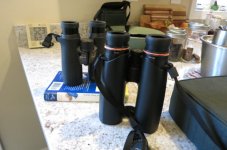I think that would have been been a good way to phrase it.
As I mentioned in the OP I don't insist on either alpha glass or Zeiss, but I tend to start there because of the "Wow!" I experienced decades ago with Zeiss and a "Meh..." with Swarovski. The Nikon Superior E moved me off of Euro-only glass, so I then posted the OP.
The short "no" answers to my questions were definitive but not particularly helpful, except in a negative sense; specifications won't lead me where I want to go, but doesn't tell me much (with a few exceptions) about how to get there. From them I gather I don't need to stick with 8x42 with its exit pupil specification to get a great view; that's good news as I search for something less heavy. Unfortunately, I live in a an optics store desert in which I can't go in and just try out bins without significant pre-planning.
So, yes, please offer different phrasing and also, please, avoid one-word answers.
For your optics store desert difficulty, you might consider contacting dealers who sell online to inquire about a home trial option.
For your question about 8x42, less heavy topic, here are some contributing factors for determining fit. The exit pupil can be calculated as objective diameter divided by magnification. For 8x42 that means the exit pupil is 5.25 mm diameter.
When viewing in bright daylight (most of my viewing), my pupils are under 2 mm. This means light in an exit pupil larger than 2 mm will have some fraction falling outside my eye pupils. However, an exit pupil wider than my eye pupil makes getting on the bird easier. When I go out with an 8x20 (2.5 mm exit pupil) on a typical bright day, even some of the light coming into the exit pupil is not collected by my eye pupil. It does take me a few minutes of use to get in the rhythm of popping that 8x20 into the right location to line up for a good view. On the other hand, my 10x42 has a 4.2 mm exit pupil and is easier to get onto a bird, though now the vast majority of light in the binocular does not enter my eye pupil. A larger exit pupil does not equate to brighter image lumens in the eye in this case.
When viewing in dim light, my eyes have pupils of 4.5 mm or smaller. This means that the benefit for me of an exit pupil over 4.5 mm is only in the ease of getting on the bird in dim light, no optical benefit for light arriving outside that size for me, this varies by person and age. And I don't use binoculars for star gazing, my dim light viewing is never that dark, just dawn or dusk typically. I recommend you measure your eye pupil diameter in light conditions covering the range in which you will be observing.
These factors can be used for fit considerations. Yet there are other linked factors, like ease of bringing the binocular onto the bird, personal eye geometry, and so on. While one can identify some specific factors for "fit" still the final analysis really requires individual trial for what works for you, not a paper prediction.
For weight, your thought to go lighter, there may be individual reasons for wanting lighter in your next step. If so, your knowledge of your own eye pupil diameter range may be useful for prediction, giving a direction worth testing. For example, if you like 8x and are comfortable getting onto bird with a 4 mm exit pupil binocular then you can look into 8x30 and 8x32 to get the weight down. Personally, I find weight can be a benefit in the case of 10x since larger mass is more stable in the hand once on the bird. But larger mass can be tiresome on a neck strap, a harness may be the choice.








